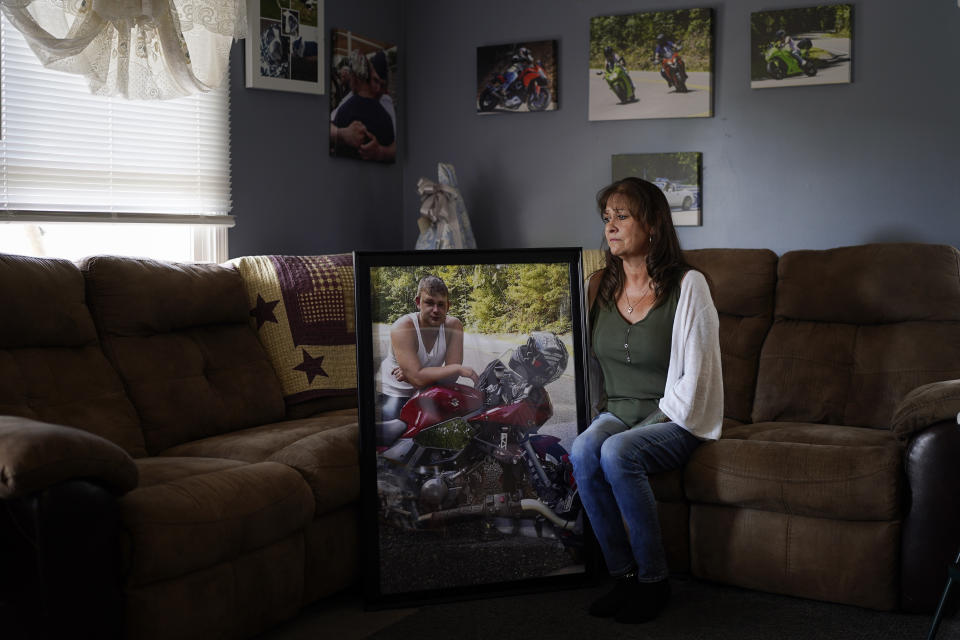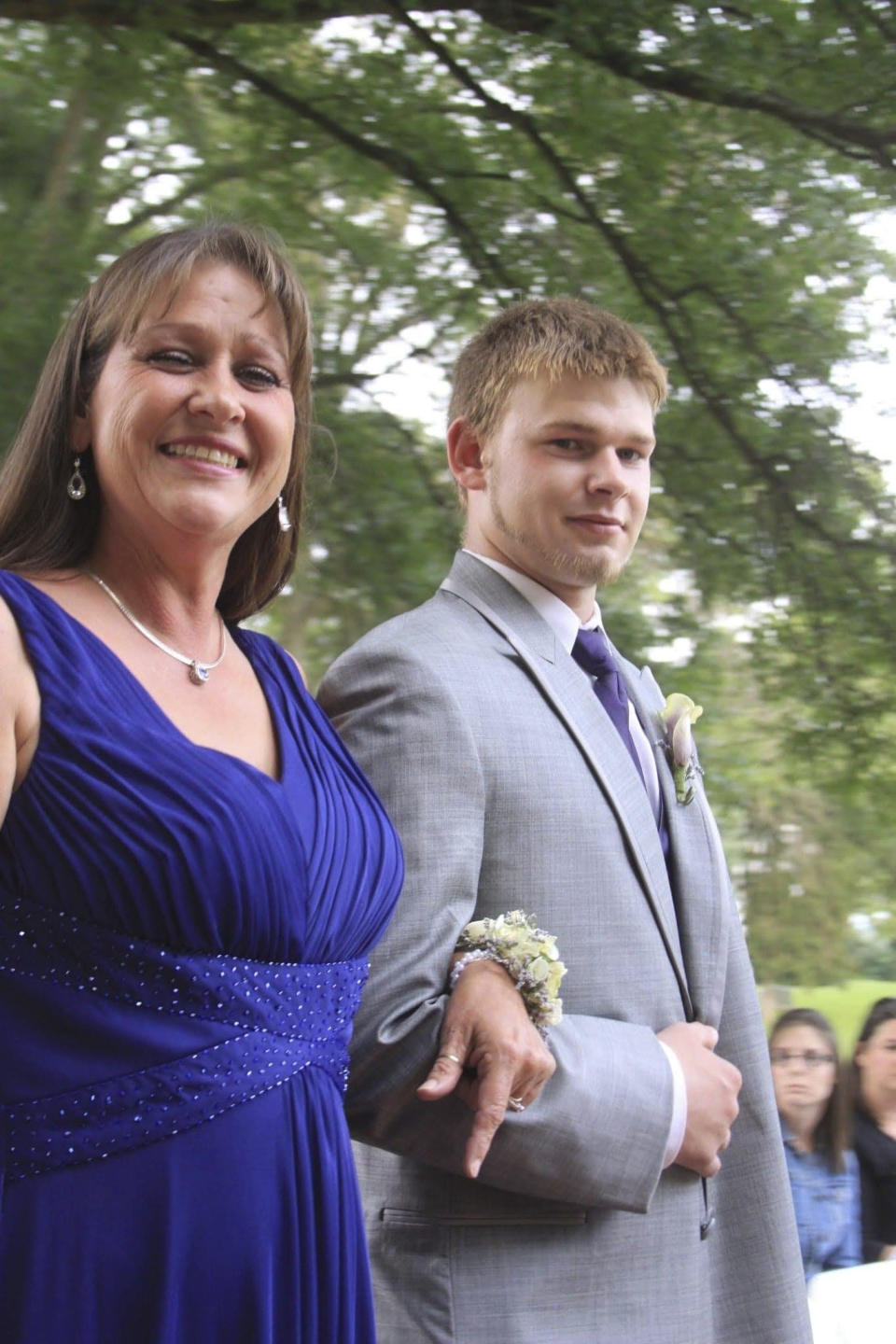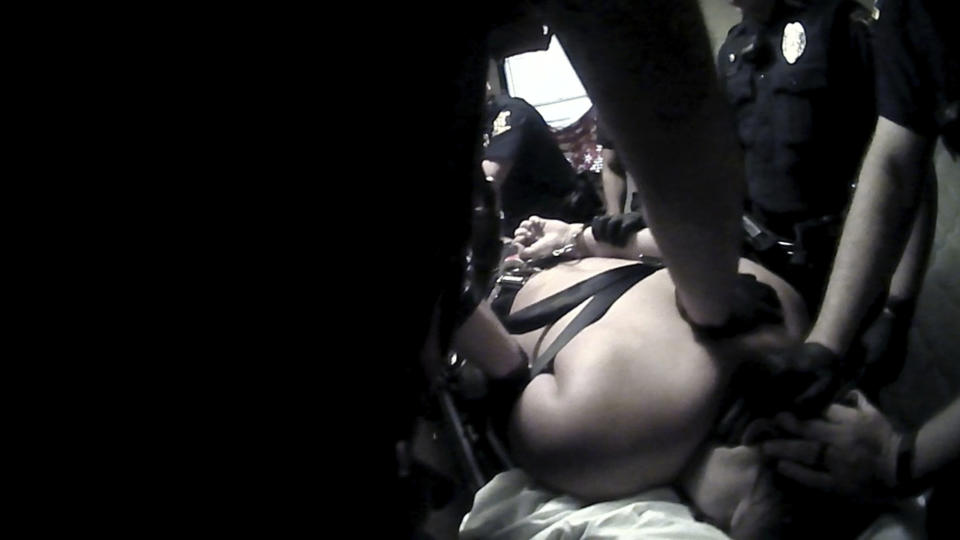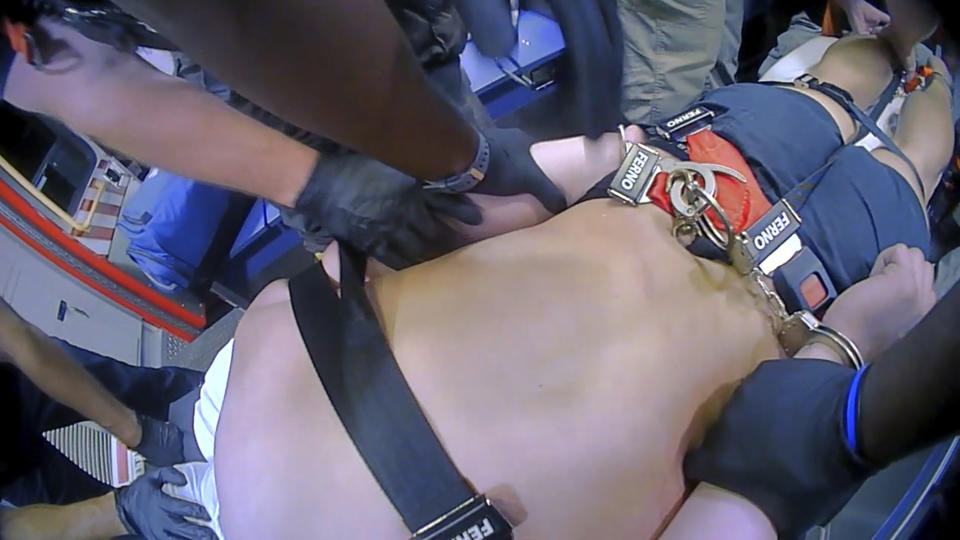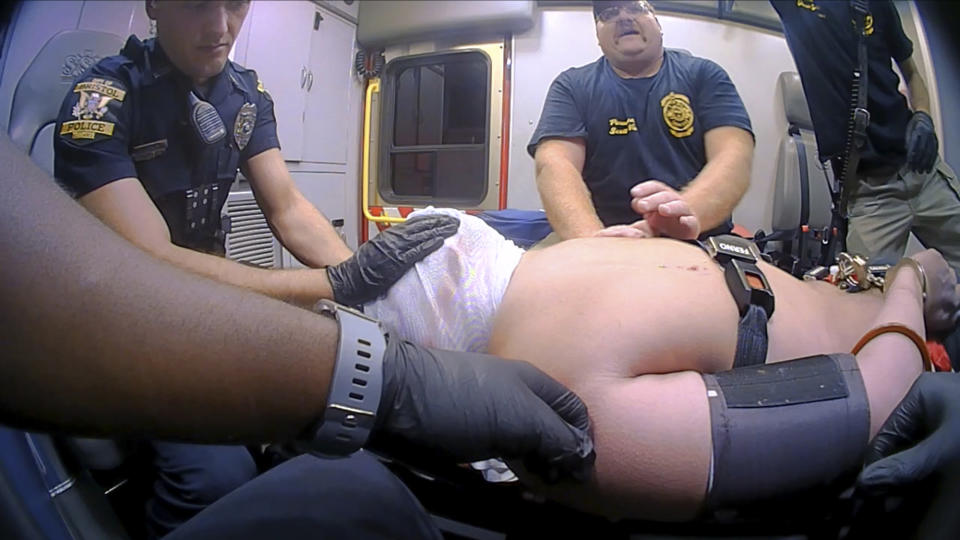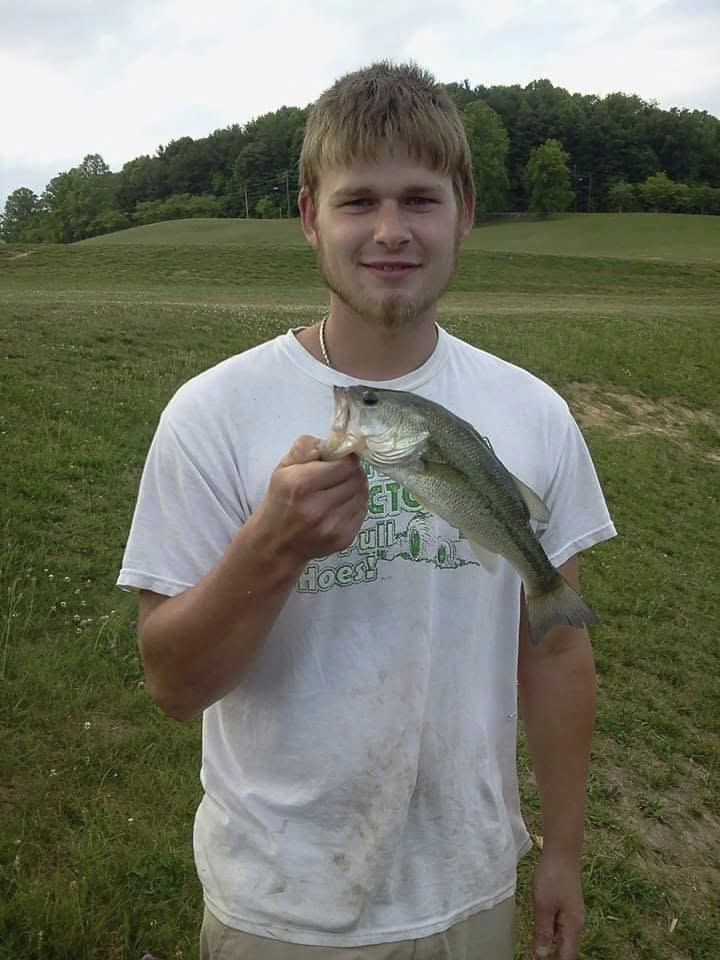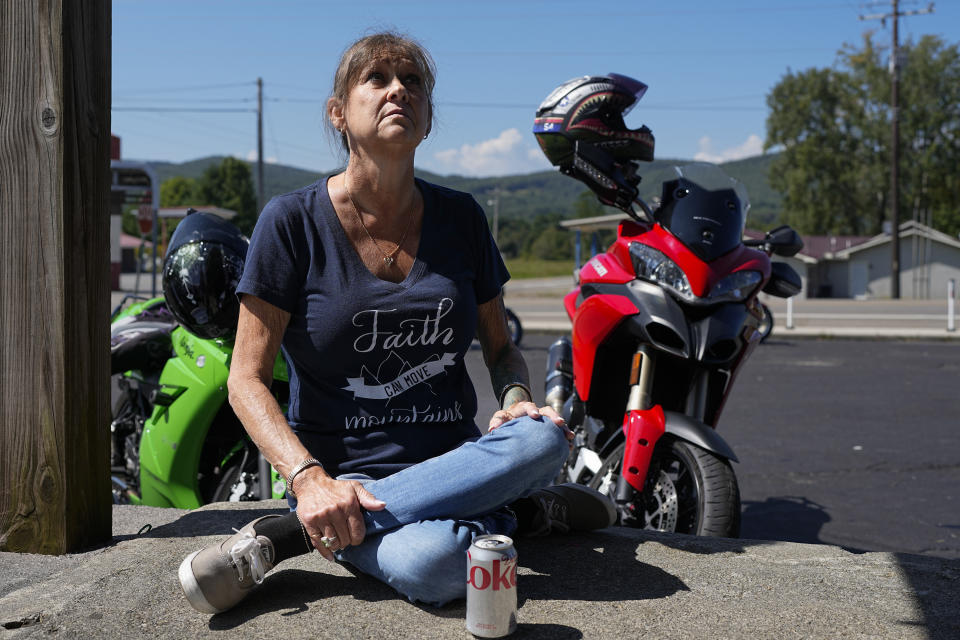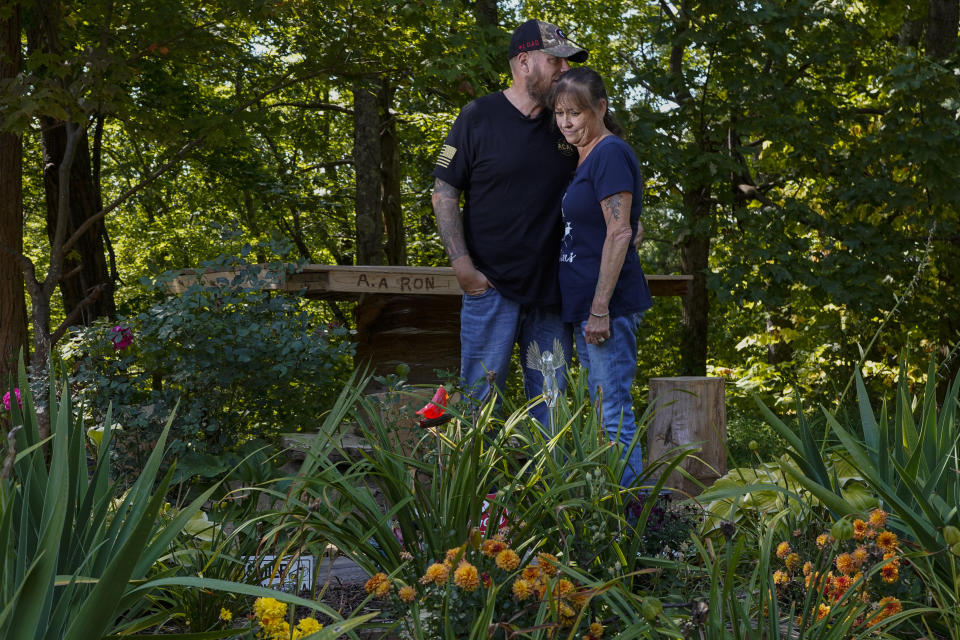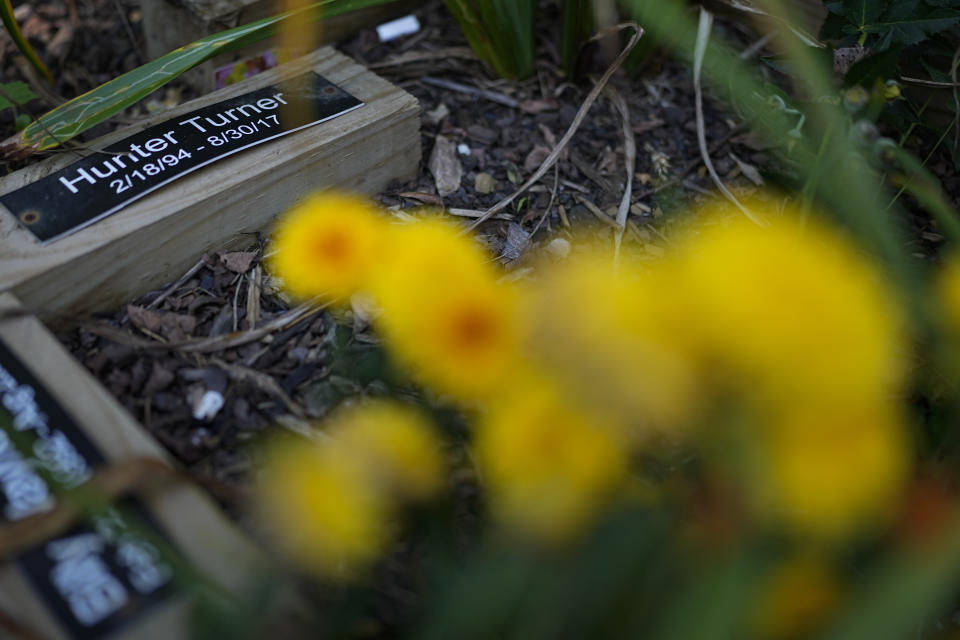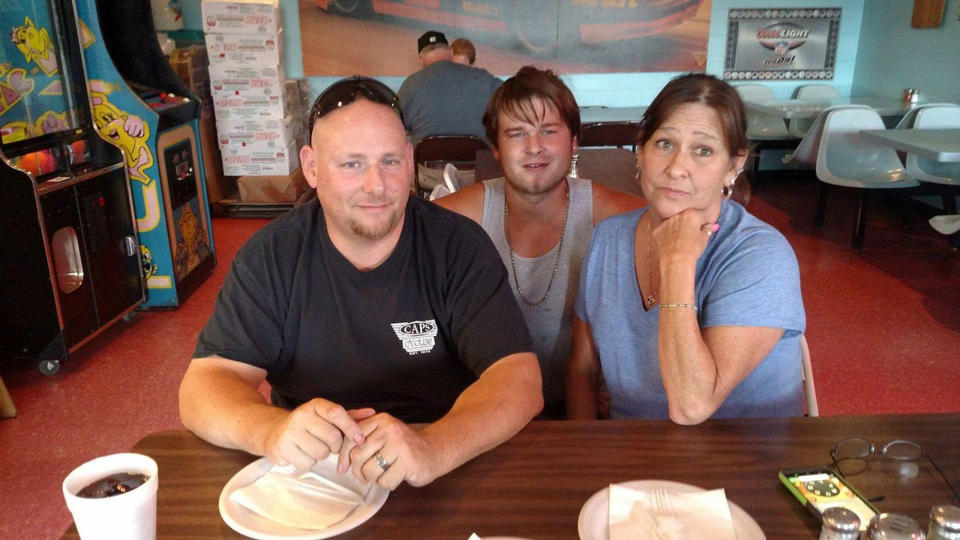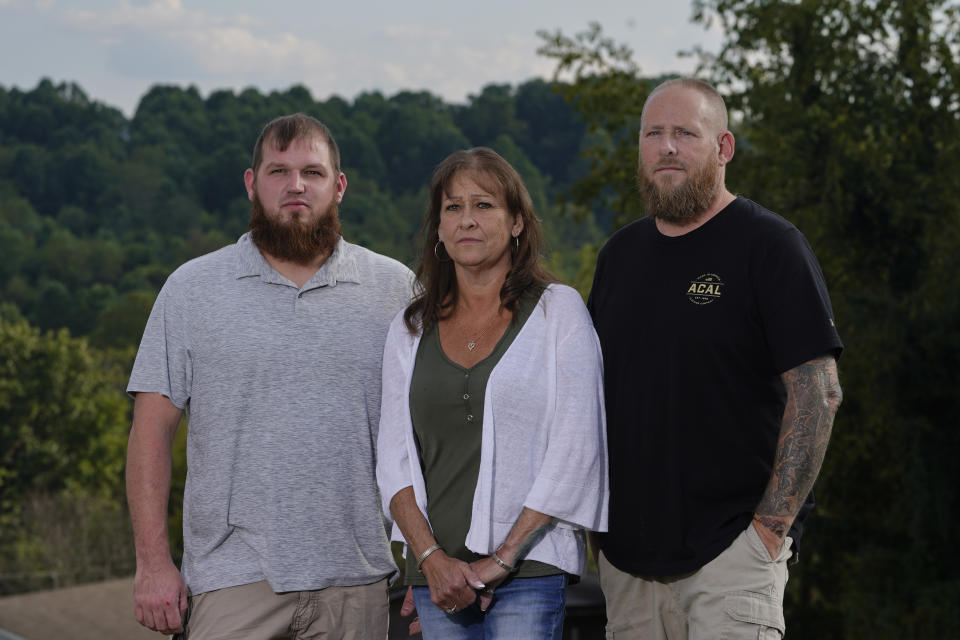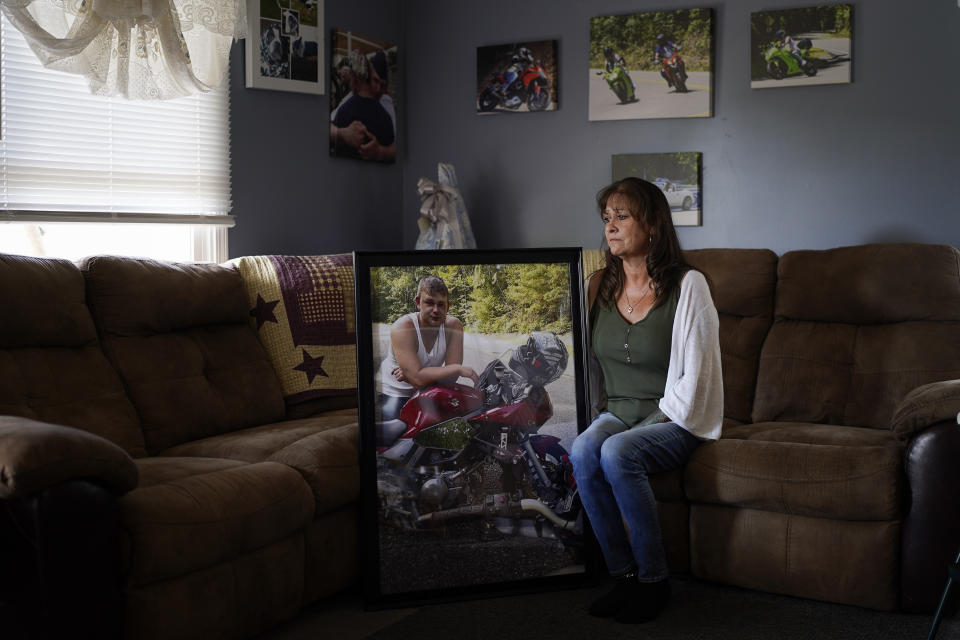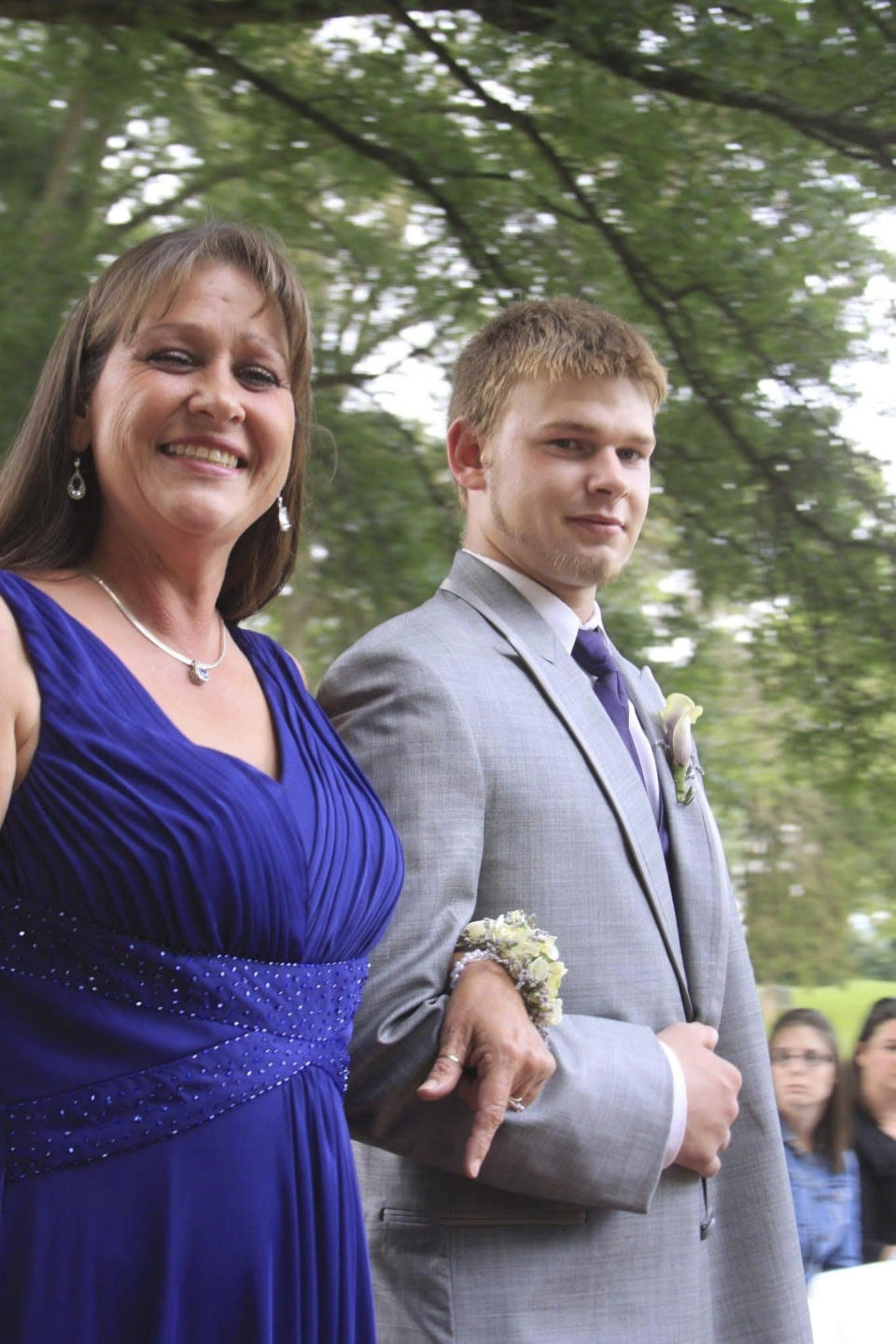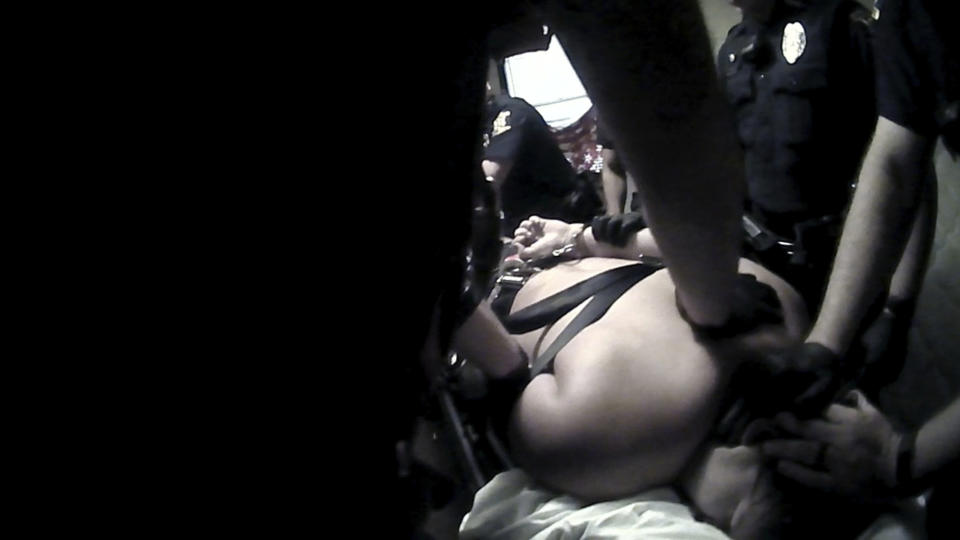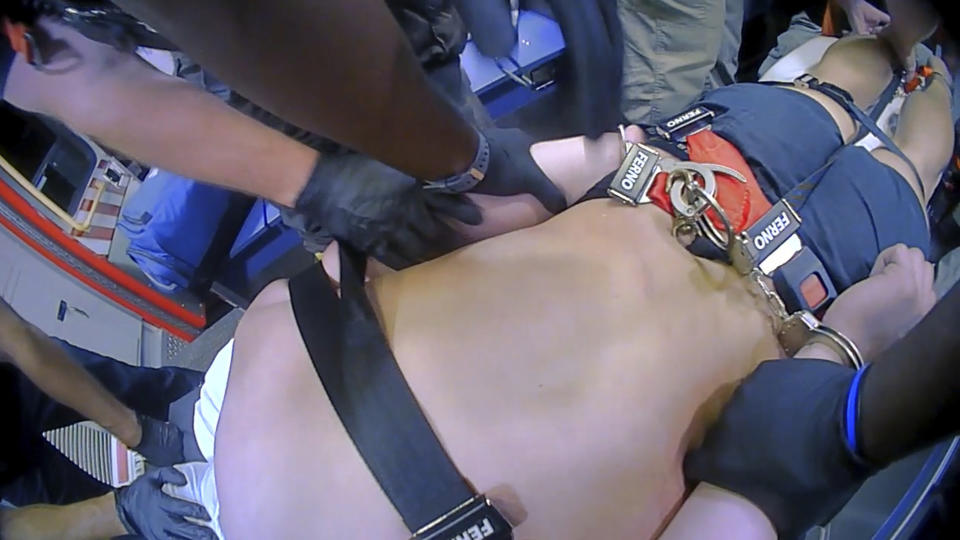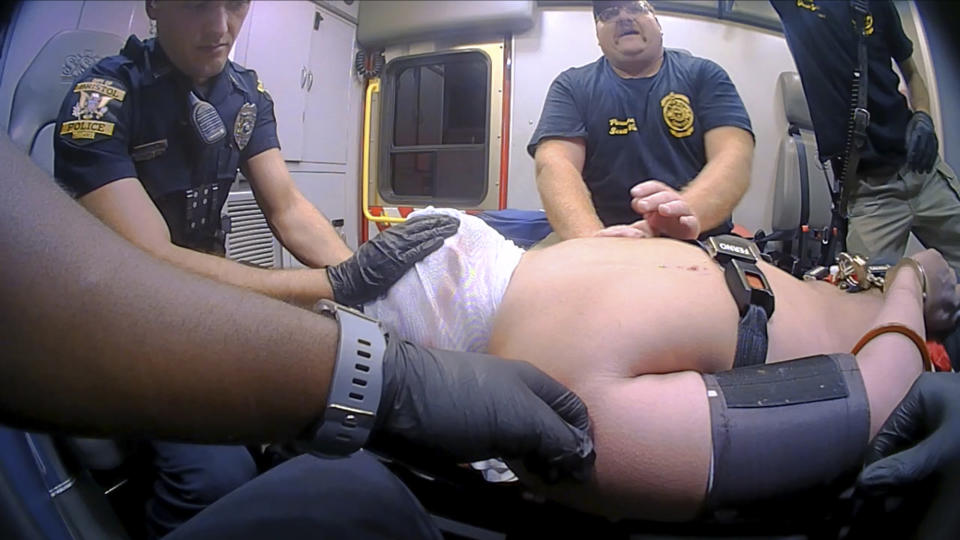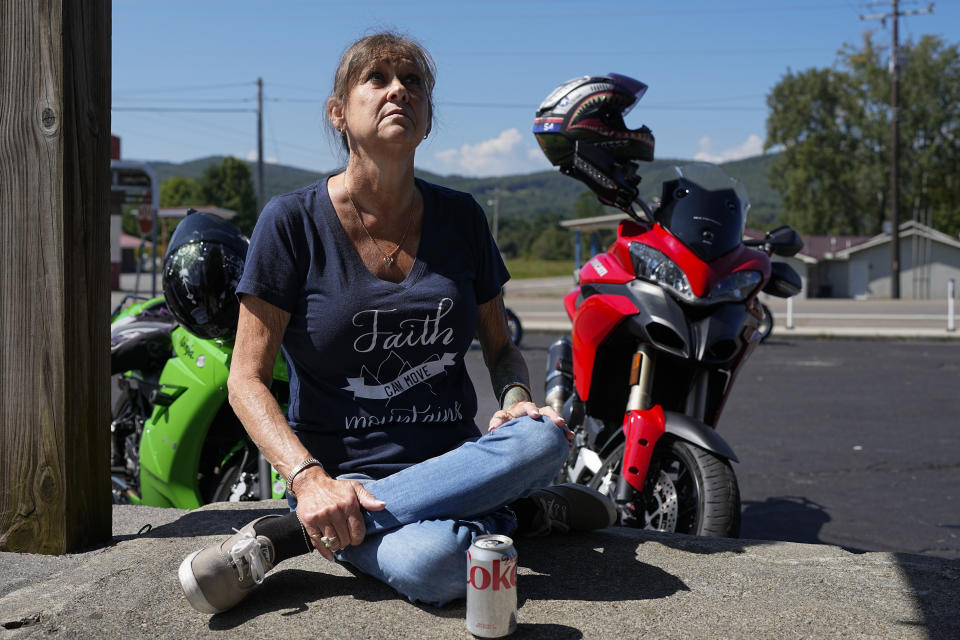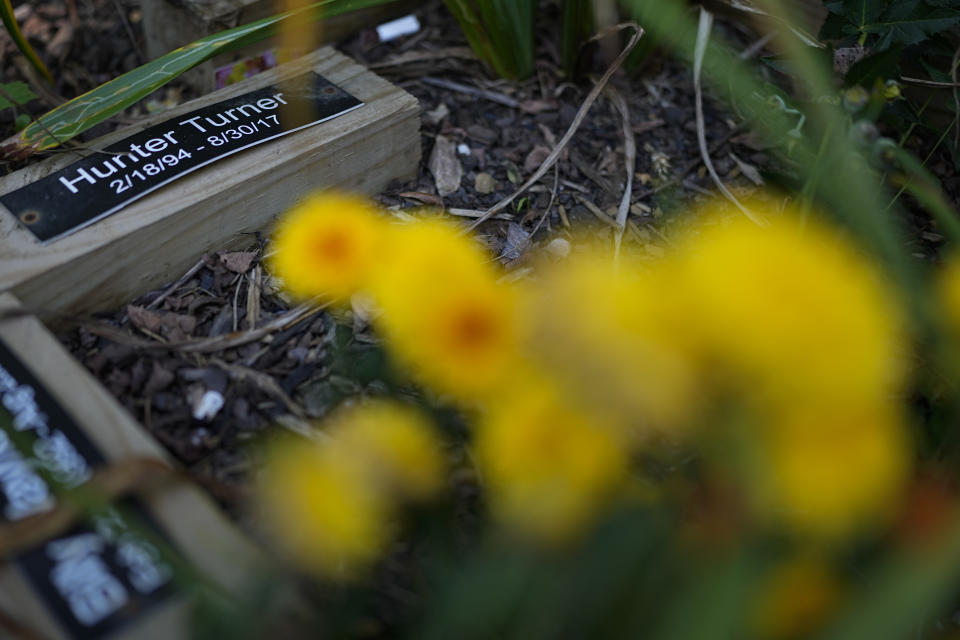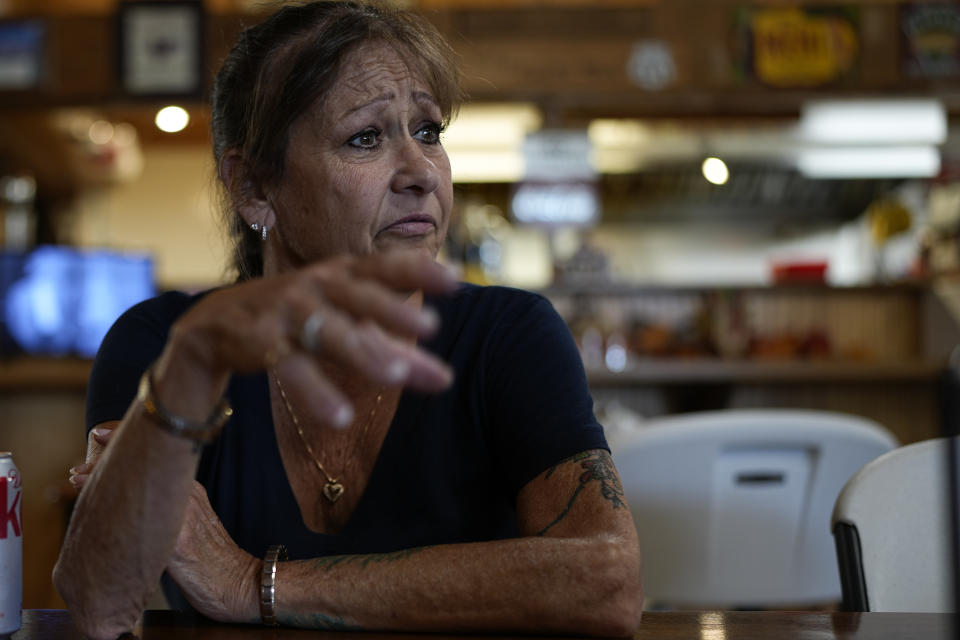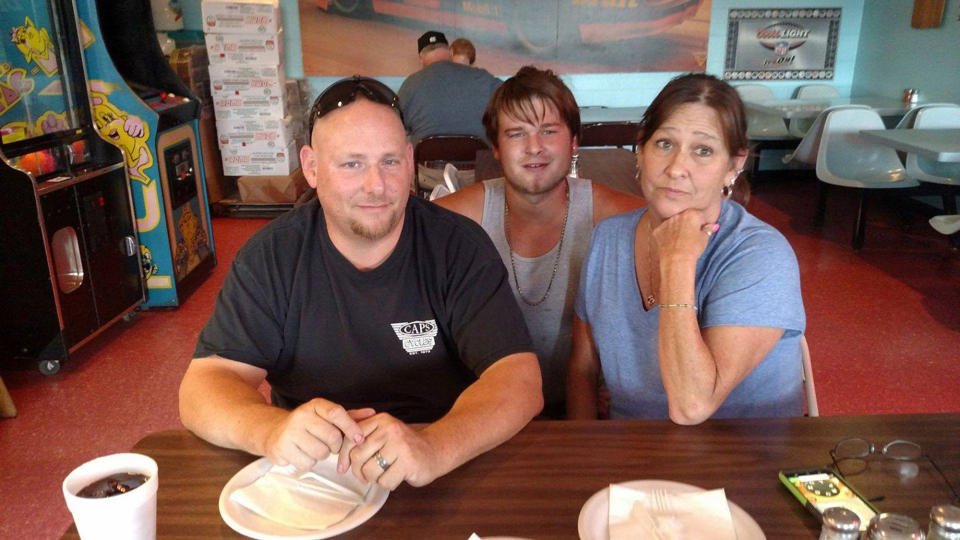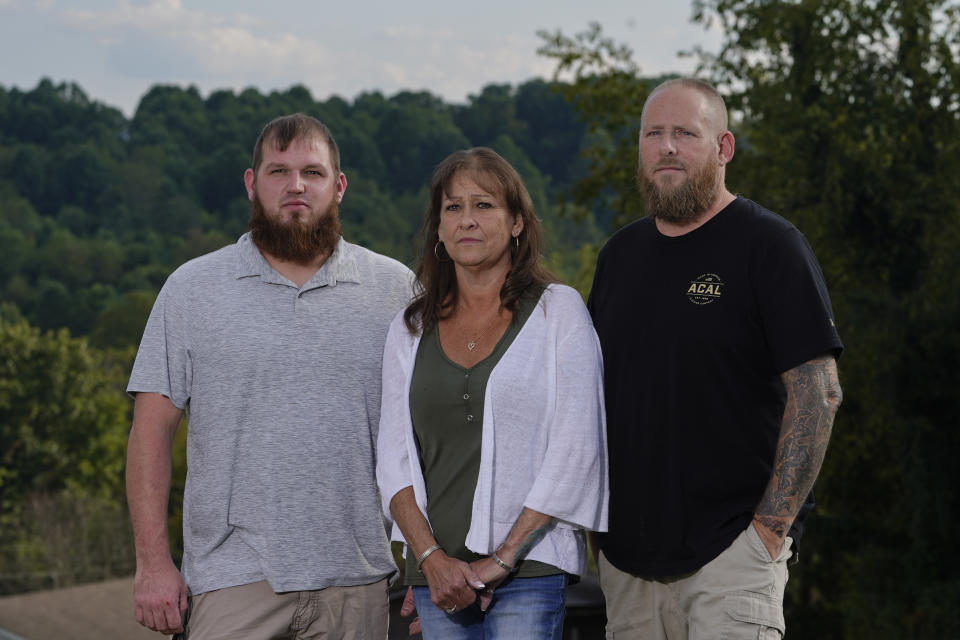For years she thought her son had died of an overdose. The police video changed all that
- Oops!Something went wrong.Please try again later.
BRISTOL, Tenn. (AP) — It was in the den that Karen Goodwin most strongly felt her son’s presence: On the coffee table were his ashes, inside a clock with its hands forever frozen at 12:35 a.m., the moment that a doctor had pronounced him dead.
As Goodwin swept and dusted the room, she’d often find herself speaking to her son, a soothing one-way conversation that helped her keep his spirit alive. She’d tell him about his nephews and nieces shopping for backpacks for the new school year, or the latest from the Bristol Motor Speedway and her motorcycle ride along Highway 421, one of the most scenic routes in the state.
“I wish you had been there,” she’d say wistfully.
Austin Hunter Turner died in 2017, on a night that Goodwin has rewound and replayed again and again, trying to make sense of what happened. Something just didn’t add up. There was the race to his apartment, the panic of watching her “baby boy” struggle to breathe, the chaos of paramedics in the kitchen. Her feelings of helplessness as she prayed for him to live.
Her emotions have been painfully conflicting. There was the deep shame that Turner died of a drug overdose. The doubts when her own memory diverged with the official police narrative. More recently, anger and outrage. She now believes she has spent all these years living with a lie that has tested what was once a resolute faith in the police, paramedics and the legal system.
Goodwin’s son is among more than 1,000 people across the United States who died over a decade after police restrained them in ways that are not supposed to be fatal, according to an investigation by The Associated Press in collaboration with FRONTLINE (PBS) and the Howard Centers for Investigative Journalism.
Turner’s case highlights a central finding of the AP investigation: In the aftermath of fatal police encounters involving the use of Tasers, brute force and other tactics, a lack of accountability permeates the justice system. From the police officers at the scene and their commanders to prosecutors and medical examiners, the system shields officers from scrutiny.
Goodwin and her family are examples of what can happen when police tactics go too far in such a system: The truth can be lost. Like the Goodwins, hundreds of families have been left to wrestle with incorrect or incomplete narratives that have recast the lives of the dead, and re-ordered the lives of those left behind.
The terrible night
Goodwin was in bed when her phone rang. It was her son’s girlfriend, Michelle Stowers. She was frantic. Turner had just collapsed on the kitchen floor.
“He’s not moving,” Stowers cried. “I don’t think he’s breathing. What should I do?”
The mother’s heart hammered.
“Call 911. I’m on my way,” Goodwin said, her mind racing through terrible possibilities.
Was her son alive? Dead? He’d had a few seizures, but they were nothing serious.
As she sped to Turner’s apartment on that warm humid night in August 2017, Goodwin called and alerted her husband, Brian, and older son, Dustin. She also dialed her sister but could only utter: “Pray for Hunter.”
When she arrived, Goodwin found her son gasping for breath on the linoleum of his kitchen floor. His eyes were vacant. His body shook. Foam spilled from his mouth.
The mother thought her son might die right then. A paramedic arrived, and Goodwin told him that Turner had suffered minor seizures before.
“Hunter, this is momma,” she said, kneeling, pressing an oxygen mask to his face.
The front door burst open, and police officers and firefighters swarmed into the tiny apartment. Medics had requested help restraining Turner to treat him. They thought Turner was resisting.
As the room filled with voices and equipment, Goodwin stepped away, relieved. She and her husband and children had always admired paramedics and police. They were heroes. And she knew they’d do everything in their power to save her son’s life.
Then an officer shouted: “Get up off the floor!” Goodwin heard another say, “You’re going to get tased if you keep it up.”
She felt bewildered. Her motherly instincts kicked in. “Please,” she implored them, “don’t hurt him more than you have to!”
The officers were pinning Turner facedown on a recliner. A few minutes later, he was strapped to a stretcher, again facedown.
Goodwin followed them to the waiting ambulance. She peered inside: Her son seemed like he was unconscious, with a strange sort of mask pulled over his head. His legs were bound.
Goodwin felt powerless. That was her son. She’d give her life for him.
‘My baby needs to rest now’
Goodwin followed the ambulance to the Bristol Regional Medical Center.
After a long wait, the emergency room doctor said that “for all intents and purposes” Turner was dead. “Your son is young and strong,” he said. “We’re going to continue working on him for that reason.”
He paused, before continuing: “We’ll take you back — if you think you can handle it.”
Steps away, she saw a team of doctors and nurses trying to get Turner’s heart pumping again. She stared at her son’s blank face when they used a defibrillator to try to shock him back to life.
Nothing worked.
“We can keep going,” the doctor said.
Goodwin waved her hand. She needed a moment. Her son wasn’t moving. He didn’t respond to her voice, or the life-saving measures. When she’d touched his chest, it felt like Jell-O, because the paramedics, nurses and doctors had crushed everything in there while trying to save him. Goodwin knew what she had to do.
“That’s enough,” she said. “My baby needs to rest now.”
As she sat in the sterile hospital waiting room, she wondered: Why her son? He’s such a gentle, kind soul, Goodwin thought. Everyone loved him.
He was boyishly handsome, with light brown hair and a small goatee and chinstrap of hair along his jawline. A few inches short of 6 feet, Turner had a strong, outdoorsy kind of look. He was outgoing, ready to chat even with strangers.
Turner had a passion for fast motorbikes and owned a maroon Suzuki SV650 that could fly along at 130 mph.
He’d hit the road with his mom and dad and buddies, racing up steep stretches of the Appalachian Mountains with hairpin turns. Sometimes, he’d turn so sharp and deep he’d scrape the knees of his jeans along the ground.
The 23-year-old Turner worked odd jobs to help make ends meet — lately it was refurbishing furniture.
“I have plenty of time to grow up,” he told his parents.
Now, as she sat there, she felt those words reverberating in her head.
An overdose?
At 4 a.m., Goodwin looked up and saw her husband rushing into the waiting room. She needed him now, more than ever.
Karen had met Brian in 1996 when he stopped to fill his tank at the gas station where she worked as a cashier. They were immediately attracted to each other. Karen was drawn to his big smile and sarcastic sense of humor, and Brian to the cashier’s sassy personality and long blonde hair. Karen and Brian were married within a year.
From the beginning, Karen loved how her husband treated her two boys from a previous marriage as his own, teaching them to hunt and fish, ride dirt bikes and motorcycles. An electrician who spent weeks on the road, he had sped the 200 miles south from West Virginia to Bristol in under three hours. Brian Goodwin, a burly tough guy who never cried, was having a hard time holding it together.
“What happened?” he asked.
Goodwin said she didn’t know. She said she’d overheard a Bristol police officer declare that Turner had died of a drug overdose.
The parents knew their son smoked marijuana. They also knew he got high using Suboxone, a drug used to wean people off opioids. But they didn’t think either drug could lead to an overdose.
It didn’t make sense to Goodwin. Why were police saying this, she wondered. They had learned from Turner’s girlfriend that he had seemed fine when she got home from her late shift at Walmart. He hadn’t acted stoned. He had collapsed out of the blue. How could this be an overdose?
Ashes
After a memorial service, the Goodwins and two dozen of Turner’s friends honored his memory with a procession of motorcycles that climbed the sharp hills of the Appalachians. When they returned to Bristol, the group said their goodbyes. That night, Goodwin felt an emptiness in her soul. It would be a long time before she felt anything else.
Brian went back to work after a month. Keeping busy helped him deal with his grief.
But Goodwin couldn’t find an outlet. The mother tattooed her left arm with an image of her son’s thumbprint, and a clock set at 12:35. The tattoo artist had mixed traces of Turner’s ashes into the ink.
Mother and son had enjoyed a special connection. He was a daredevil, a fun-loving kid. Whenever something went wrong — like the time he hurt himself jumping off a neighbor’s porch, or crashing her car into a utility pole as he tried to teach himself to drive a stick shift — he’d run straight to her. And she was always there to say, “It’s all right, Hunter. It’s all right.”
Her son had always been there for her, too. When she had been diagnosed with cancer in 2015 and surgeons had removed one of her lungs and part of the other, her son had been the one to cheer her up.
Every morning he’d sit next to his mother on the front porch, covering her with a blanket to keep her warm. Sometimes, he’d hold his mother’s trembling hands and whisper, “I love you. You’ll be OK, Mom. You’ll be OK.”
Now, Goodwin wrestled with existential questions. Why did she fight so hard to beat cancer only to have her son die before her?
As the years wore on, she found solace in the den, next to her son’s ashes. Sometimes, she’d think about the weeks and months following Turner’s death. When she obtained his autopsy report, it explained that he died of an overdose and repeated the official police version of events — that officers had gone to Turner’s apartment to help the young man, but he had been too stoned to cooperate. He fought them, and in the end, it had cost him his life.
During that period, she had heard from police that they had tried to save Turner but couldn’t because of the drugs and his heart.
A strong supporter of law enforcement, Goodwin desperately wanted to believe that police and paramedics had acted appropriately. But something was gnawing at her. Sometimes, she’d wake up in the middle of the night and hear the police officer threatening to fire his Taser.
She’d recall that her son seemed to be having a seizure, and police held him down as he struggled to breathe. She had a hard time squaring those actions with what she knew in her heart was a medical emergency.
But she just didn’t trust her recollection. She felt constantly at war — her memory pitted against her deep trust in the police.
And more times than not, she ended up pushing her doubts aside. Why would the police lie? She wanted to believe they had done everything they could to save her son.
The Hard Truth
On Aug. 14, she heard a knock on her door. When she opened it, she found two Associated Press reporters who asked if she wanted to know more about how her son had died. They had videos that the family had never seen.
It was not easy for Goodwin to take them up on the offer. She knew it would be painful to revisit the worst night of her life.
After a week of agonizing, she sat down at her kitchen table and stared at a laptop before hitting play on the videos captured by police body cameras. The house was quiet except for the ping of a wind chime.
The videos on her computer screen took Goodwin straight back. Body cameras worn by officers Eric Keller and Kevin Frederick had captured most of the interactions between police, paramedics and Turner.
At times, the figures were difficult to make out, but one thing was clear: From the first moment police arrived, Turner was treated as a suspect resisting arrest — not as a patient facing an emergency.
Goodwin watched in horror as police officers seemed to ignore the fact they had been dispatched to a medical call.
Paramedics tried to force Turner onto his feet. He managed to get to his knees and momentarily stand. He took a single step and toppled over.
Officers began screaming that Turner was resisting arrest, being combative and disobeying their commands. But the video seemed to show Turner was having a seizure.
During a seizure, the muscles of the arms, legs and face stiffen, then begin to jerk. The videos showed that Turner was not throwing punches. He wasn’t kicking.
When Keller bounded into the apartment, the video shows he yelled at the flailing Turner, who was pinned down in a recliner chair, “You’re going to get tased if you keep it up.”
Despite paramedics warning him to wait, about 10 seconds later Keller pulled the trigger. Goodwin flinched when she heard the weapon’s loud pop followed by her son’s painful cry, as electricity coursed through his body.
“You’re not going to win this battle,” another paramedic said.
Goodwin was aghast.
“Win what?” she thought. “This isn’t a contest. My son isn’t resisting. He’s dying!”
The force didn’t end there. A paramedic sprayed a sedative up Turner’s nose, but most of it ended up on the medic.
Police kept restraining Turner — even after he was handcuffed facedown on top of the recliner. They shackled his legs.
When police transferred Turner to a gurney, they again put him facedown and strapped him in place. As blood spilled from his mouth, they covered his head with a spit hood.
Once inside the ambulance, an officer sat on Turner’s body — even though he was still on his stomach. There was no rush to get him to the hospital. Instead, the body camera showed police officers and paramedics spent six minutes recounting the “battle.”
It was only then that a paramedic noticed that Turner wasn’t breathing. Attendants removed the restraints, flipped him over, and began CPR. After about 10 minutes a paramedic walked into the frame. For a moment, he studied his colleagues who were working feverishly to revive Turner. He looked puzzled.
“What the hell happened here?” he asked. “Did we cut his damn airway off?”
They said no. As medics continued to work on Turner, the quizzical paramedic asked, “Y’all ain’t recording are you?”
The officer turned off his body camera. Goodwin’s screen suddenly went blank.
‘A damn lie’
The Goodwins were livid. The videos raised disturbing questions. So, they decided to drill down into documents –- the police reports and autopsy –- to try to find answers.
They soon became convinced the Bristol law enforcement community had lied about what had happened.
Police didn’t include any statements in their reports from Karen Goodwin and her other son, Dustin, who had been in the apartment during the encounter. The events police described were a far cry from what Goodwin and her son had seen, or what was captured by the body cameras. They had made Turner out to be a villain.
In a report, Lt. Greg Brown said the paramedics told police the young man was reaching for a knife on the kitchen counter.
“A damn lie,” Goodwin thought. She’d seen a paramedic clear the counters before police arrived.
Keller said he fired his Taser to stop Turner from fighting the medical personnel.
Goodwin knew her son was dazed from the seizures. He wasn’t fighting back. They had no reason to stun him.
Brown wrote in a report that Turner was fighting with medics when he arrived at the apartment. Goodwin was there. She saw no such thing. The body camera showed the opposite.
Using buzzwords that painted the victim as the aggressor, Brown said Turner was “combative,” “agitated,” and had “ignored commands.” Brown noted that Turner had incredible strength like those under the influence of narcotics.
Sullivan County District Attorney Barry Staubus had asked the Tennessee Bureau of Investigation to examine Turner’s death.
The investigator talked to witnesses and collected other details, Staubus said in an interview with AP. But after reviewing the TBI report and the body-camera footage, Staubus concluded that Turner died of a drug overdose. Nothing in the autopsy concluded the force and “restraint techniques” had caused or contributed to Turner’s death.
The Goodwins expressed reservations about the state’s investigation and the prosecutor’s decision to shield police from accountability. They noted that state investigators never reached out to two of the most important witnesses: Karen Goodwin and Dustin. The state investigator had sent messages to Turner’s girlfriend and a neighbor at the scene, asking if they’d talk. They said yes.
They never heard from the investigator again.
Tennessee law keeps confidential the state’s investigation files, including those that detail fatal police encounters – unless the death involves a shooting. The Tennessee Bureau of Investigation declined to discuss Turner's death.
Bristol’s chief of police would not answer questions when reached by the AP. Lt. Brown and officers Keller and Frederick did not reply to requests for comment, and neither did paramedics involved. The Bristol Fire Department did not respond to repeated requests for comment.
The Goodwins were also perplexed by the autopsy report. Medical Examiner Eugene Scheuerman had declared Turner’s death an accident. He died of “Multiple Drug Toxicity” related to his use of the opioid in Suboxone and the psychoactive chemical in marijuana.
An analysis found a “therapeutic to lethal level” of Suboxone in Turner’s system. Scheuerman added that “dilated cardiomyopathy” — a condition that affects the heart’s ability to pump enough oxygen-rich blood — was a contributing factor to Turner’s death.
The autopsy report also repeated the police version of events.
He didn’t note that police officers had placed Turner facedown and applied their body weight, a tactic that has long been criticized by experts for restricting breathing.
The Goodwins wondered if the medical examiner had bothered to watch the police videos. Scheuerman has since died.
Three experts who reviewed the documents for AP related to the incident disagreed with the autopsy findings: they said Turner did not die of a drug overdose. Instead, they said the Bristol police made critical errors that contributed to Turner's death, including placing him facedown in a way that could restrict his breathing.
"They didn't understand the dangers of prolonged restraint and the pressure on his back," said Jack Ryan, a police training expert and a former police officer and administrator.
Forever midnight
Karen and Brian Goodwin said they were still figuring out how to come to terms with the truth. They had blamed their son for his own demise and had felt incredibly guilty about that. They are now convinced he didn’t die from drugs — he was killed by police force.
What hurts so much is that many people in town believe Turner died of an overdose. The parents still can hear the whispers in grocery stores and restaurants: Their boy would still be alive if he hadn’t been a drug user.
“That’s the stigma that we’ve had to live with, ‘Your son was a dumbass.’ We’ve had to live with that as his legacy,” Brian said. “I want everyone to know the truth.”
What’s next? A lawsuit? Becoming advocates for holding police accountable in arrest-related deaths so another family doesn’t go through their pain? They wonder how they will react if police pull them over along the road. They still support the police. But will they be respectful?
Karen worries she may be running out of time. Her health, fragile from the cancer fight, has been flagging. She is glad she learned the truth, but she fears she won’t live long enough to do anything with it.
“My son didn’t do this to himself,” Karen said, fighting back tears. “He didn’t have to die … His death killed a part of us.”
She turned and studied the clock on the coffee table. Even with all the new information, the clock’s hands remain fixed, unmoving, stuck forever at 35 minutes past midnight.
___
AP reporter Reese Dunklin contributed to this report from Dallas.
___
This story is part of an ongoing investigation led by The Associated Press in collaboration with the Howard Center for Investigative Journalism programs and FRONTLINE (PBS). The investigation includes the Lethal Restraint interactive story, database and the documentary, “Documenting Police Use Of Force,” premiering April 30 on PBS.
___
The Associated Press receives support from the Public Welfare Foundation for reporting focused on criminal justice. This story also was supported by Columbia University’s Ira A. Lipman Center for Journalism and Civil and Human Rights in conjunction with Arnold Ventures. The AP is solely responsible for all content.
___
Contact AP’s global investigative team at Investigative@ap.org or https://www.ap.org/tips/
